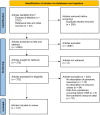A systematic literature review on public health and healthcare resources for pandemic preparedness planning
- PMID: 39529010
- PMCID: PMC11552315
- DOI: 10.1186/s12889-024-20629-z
A systematic literature review on public health and healthcare resources for pandemic preparedness planning
Abstract
Background: Generating insights into resource demands during outbreaks is an important aspect of pandemic preparedness. The EU PANDEM-2 project used resource modelling to explore the demand profile for key resources during pandemic scenarios. This review aimed to identify public health and healthcare resources needed to respond to pandemic threats and the ranges of parameter values on the use of these resources for pandemic influenza (including the novel influenza A(H1N1)pdm09 pandemic) and the COVID-19 pandemic, to support modelling activities.
Methods: We conducted a systematic literature review and searched Embase and Medline databases (1995 - June 2023) for articles that included a model, scenario, or simulation of pandemic resources and/or describe resource parameters, for example personal protective equipment (PPE) usage, length of stay (LoS) in intensive care unit (ICU), or vaccine efficacy. Papers with data on resource parameters from all countries were included.
Results: We identified 2754 articles of which 147 were included in the final review. Forty-six different resource parameters with values related to non-ICU beds (n = 43 articles), ICU beds (n = 57), mechanical ventilation (n = 39), healthcare workers (n = 12), pharmaceuticals (n = 21), PPE (n = 8), vaccines (n = 26), and testing and tracing (n = 19). Differences between resource types related to pandemic influenza and COVID-19 were observed, for example on mechanical ventilation (mostly for COVID-19) and testing & tracing (all for COVID-19).
Conclusion: This review provides an overview of public health and healthcare resources with associated parameters in the context of pandemic influenza and the COVID-19 pandemic. Providing insight into the ranges of plausible parameter values on the use of public health and healthcare resources improves the accuracy of results of modelling different scenarios, and thus decision-making by policy makers and hospital planners. This review also highlights a scarcity of published data on important public health resources.
Keywords: Bed occupancy; COVID-19; Health Workforce; Public health; Systematic review.
© 2024. The Author(s).
Conflict of interest statement
Figures
References
-
- Guan D, Wang D, Hallegatte S, Davis SJ, Huo J, Li S, et al. Global supply-chain effects of COVID-19 control measures. Nat Hum Behav. 2020;4(6):577–87. - PubMed
-
- Wu H, Soe MM, Konnor R, Dantes R, Haass K, Dudeck MA et al. Hospital capacities and shortages of healthcare resources among US hospitals during the coronavirus disease 2019 (COVID-19) pandemic, National Healthcare Safety Network (NHSN), March 27–July 14, 2020. Infection Control & Hospital Epidemiology. 2021:1–4. - PMC - PubMed
-
- Zhang L, Chai L, Zhao Y, Wang L, Sun W, Lu L, et al. Burnout in nurses during the COVID-19 pandemic in China: new challenges for public health. Biosci Trends. 2021;15(2):129–31. - PubMed
Publication types
MeSH terms
Grants and funding
LinkOut - more resources
Full Text Sources
Medical


